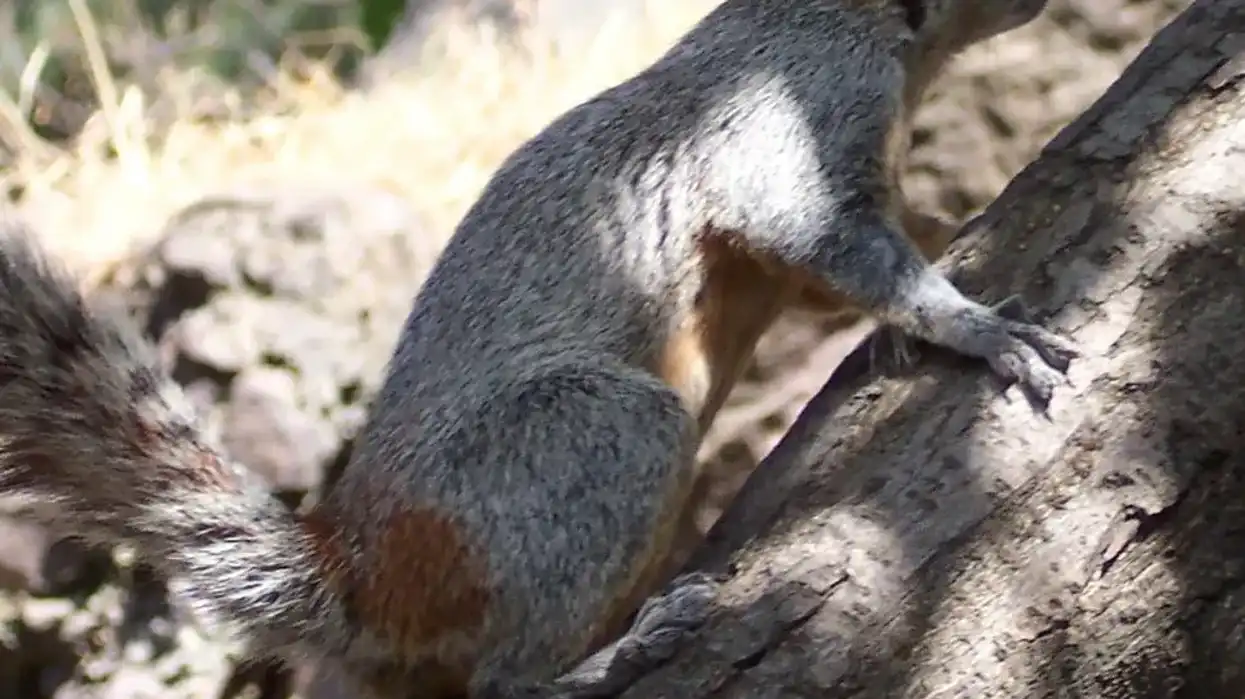The black giant squirrel (Ratufa bicolor), also known as the Malayan giant squirrel, is a species of mammals endemic to the southern and southeastern range of Asia, mainly the Indomalayan range.
The average black giant squirrel size makes it one of the biggest squirrel species and it lives in mainly coniferous and semi-evergreen forest habitats.
The black giant squirrel species is known for being bicolor, with half their bodies being a very dark brown to black, and the other half being tan or buff. It is a herbivore species that eats seeds and fruits mainly and is not harmful to humans.
The biggest black giant squirrel threat in the forest comes from animals such as snakes and birds of prey like hawks and eagles.
The black giant squirrel is a solitary creature that lives at elevations close to 6560 ft (2000 m ) above sea level, for close to 19 years.
The black giant squirrel is a Near Threatened species, with its numbers declining due to excessive hunting for food as well as a loss of habitat due to deforestation.
For more relatable content, check out these fox squirrel facts and red squirrel facts for kids.
Black Giant Squirrel Interesting Facts
What type of animal is a black giant squirrel?
The black giant squirrel (Ratufa bicolor) or the Malayan giant squirrel is a tree squirrel.
What class of animal does a black giant squirrel belong to?
The black giant squirrel (Ratufa bicolor) species belongs to the Mammalia class of animals.
How many black giant squirrels are there in the world?
The exact number of black giant squirrels (Ratufa bicolor) in the world is uncertain.
Where does a black giant squirrel live?
The black giant squirrel (Ratufa bicolor) species lives in the subtropical and tropical range of coniferous forest in South Asia, and in a broadleaf habitat in the semi-evergreen forests of Southeast Asia. Although Southeast Asia has coniferous parts, the black giant squirrel is rarely seen living here.
Its range includes native regions such as northern Bangladesh, Bhutan, northeast India, southern China, eastern Nepal, Bhutan, Myanmar, Thailand, Laos, Malaysia, Vietnam, Cambodia, and western Indonesia.
What is a black giant squirrel's habitat?
The black giant squirrel (Ratufa bicolor) species prefers dense, wild forests over plantations. These mammals may live in varied elevations, between sea level (rarely) and 6560 ft (2000 m), but more commonly they are found way above sea level between 6234-6560 ft (1900-2000 m).
The black giant squirrel feeds on the ground but lives in trees. They nest under the canopy of trees and have a special liking for white pine trees in Vietnam.
Who do black giant squirrels live with?
The black giant squirrel (Ratufa bicolor) is a tree squirrel species that mostly lives alone, but they may sometimes be found in pairs or small groups.
How long does a black giant squirrel live?
The average black giant squirrel lifespan is 18-19 years.
How do they reproduce?
Black giant squirrels reproduce by mating and females give birth to live young. Reproduction takes place in the breeding season for the black giant squirrel, which lasts from July to August and sometimes from March to April.
After reproduction, the female gives birth to one or two kittens after a gestation period of 28-35 days and the nest is built in hollow tree trunks. The kittens are fed by the female for close to five weeks after the gestation period and birth.
What is their conservation status?
The conservation status of the black giant squirrel species according to the IUCN is Near Threatened.
Black Giant Squirrel Fun Facts
What do black giant squirrels look like?
With a body length of 13–15 in (34-37 cm), the black giant squirrel is one of the largest squirrel species to exist. Its tail has a length of 16–17 in (41-42 cm), and unlike most squirrels, it is limp and does not curl from the back.
The best identifying feature of the black giant squirrel is its dark brown to black fur. The fur on its back is black, but its chest is tan or buff.
Its ears and tail are brown to black as well. Males and the females of the black giant squirrel species look identical, meaning they are not sexually dimorphic.
How cute are they?
Black giant squirrels are an extremely cute family of animals. They have impeccable habits and decidedly beautiful bicolored bodies, and they have bodies larger than most squirrels, which is quite a sight to see.
How do they communicate?
Black giant squirrels use vocal barks and chirps to communicate with one another. They sound alarm calls in the presence of a predator and they also use their bicolored bodies to avoid predation in the forests.
How big is a black giant squirrel?
The black giant squirrel is 13–15 in (34-37 cm) in length, and it has a tail length of 16–17 in (41-42 cm), which makes it twice as big as the Indian palm squirrel.
How fast can a black giant squirrel run?
Black giant squirrels, much like other squirrel species, may run as fast as 20 mph (32 kph).
How much does a black giant squirrel weigh?
A black giant squirrel may weigh anywhere between 2.3–2.8 lb (1.05-1.25 kg).
What are the male and female names of the species?
Males and females of the black giant squirrel species are called 'buck' and 'doe' respectively.
What would you call a baby black giant squirrel?
A baby giant squirrel is called a 'pup', 'kit', or a 'kitten'.
What do they eat?
Black giant squirrels are herbivores that eat food such as seeds, pine cones, fruits, as well as various leaves in the forests.
Are they dangerous?
No, black giant squirrels from the Ratufa genus are not dangerous in their behavior.
Would they make a good pet?
Black giant squirrels are a Near Threatened wild species of animals that live in forests. They should not be taken as pets, and extra efforts should be made to ensure their populations survive and thrive in the black giant squirrel native habitat.
Did you know...
These giant squirrels of India have lots of mating rituals in their breeding behavior. The mating rituals of the black giant squirrels involve urination by both the male and female on the ground.
Males do the chasing, while a female may run and hide during mating. A female also offers a younger male group of squirrels a shot at mating before the older, dominant group chases them away.
The black giant squirrel belongs to the genus Ratufa. This group is sometimes called 'Oriental giant squirrels'. It also belongs to the family Sciuridae. The family name Sciuridae is synonymous with the squirrel family, but it includes prairie dogs, groundhogs, chipmunks, and many other rodents too. Animals from the Sciuridae family are small to medium-sized.
Black giant squirrels favor southern habitats in Thailand and are known by the name 'pamaew'.
The black giant squirrel stands as one of the biggest squirrel species, rivaled only by the Indian giant squirrel. While the black giant squirrel has a body length of 13–15 in (34-37 cm), the Indian giant squirrel's body length is 10-20 in (25-50 cm).
The Indian giant squirrel has a tail that is about the same size as its body, and the black giant squirrel has a tail longer than its body, at 16-17 in (41-42 cm). These two are the biggest species of squirrels in the world.
The black giant squirrel is not exactly a rare species, existing in the heavily forested areas of Nepal, China, Vietnam, and elsewhere throughout the Malay Peninsula. However, they inhabit the canopies of tall trees which are being felled constantly.
The high elevation forests that they live in are also decreasing in size, leading to habitat loss.
They are often sold for meat in markets, and their populations have also suffered from overhunting. They have graduated into the Near Threatened category under the IUCN due to their declining populations and they may become vulnerable and rarer very soon.
Are black giant squirrels endangered?
The official status of the black giant squirrel is Near Threatened as per the IUCN; they are not endangered. This is due to deforestation, habitat loss, and predation by hawks, snakes, and eagles. They are hunted for meat and their habitat has been destroyed for human settlements.
They require tall, dense forests to survive. They live under the canopy of trees that are being felled for harvesting timber and human-preferred agriculture. According to the IUCN, a black giant squirrel Endangered status may soon become an unwanted reality.
How did the black giant squirrel get its name?
The 'giant' in its name comes from being one of the biggest squirrel species that exists. It gets 'black' in its name because half of its body is black in color, specifically the underparts, ears, and tail.
Here at Kidadl, we have carefully created lots of interesting family-friendly animal facts for everyone to discover! Learn more about some other mammals from our nutria facts, or gopher interesting facts pages.
You can occupy yourself at home by coloring in one of our free printable black giant squirrel coloring pages.









